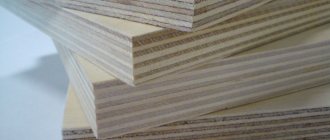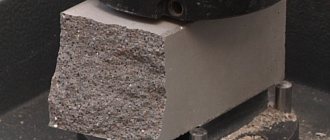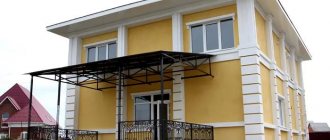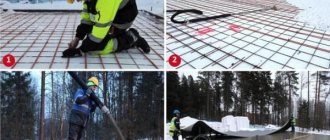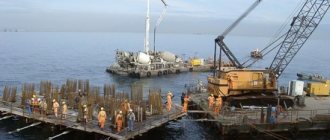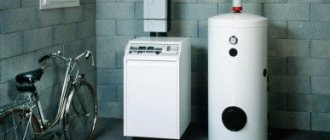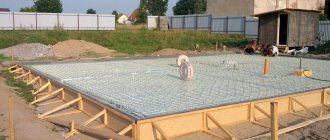With the onset of cold weather, working with concrete becomes much more difficult. First of all, builders are faced with problems of instant hydration of the solution. In winter, water turns into crystals much faster than the concrete solution has time to harden. In order for the concreting process to follow all the canons of construction, and as a result you can get a strong and high-quality structure (foundation), you must adhere to certain rules. For winter concreting, special anti-frost additives should be used, which not only increase resistance to low temperatures, but also increase the quality of the mixture itself. Let's talk about this in more detail.
Features of winter concreting
There are two important reasons that complicate the process of laying concrete in winter.
- At low temperatures, the process of cement hydration slows down, which causes an increase in the time it takes for concrete to harden. The full strength gain of concrete when using an antifreeze additive occurs after 90 days at a design concrete discharge temperature of 0 °C, according to recommendations for the use of antifreeze additives in concrete.
Increase in strength of concrete with antifreeze additive:
| Estimated concrete curing temperature according to C | Concrete strength % of design. When hardening in frost over a period of time, days | |||
| 7 | 14 | 28 | 90 | |
| 0 | 35 | 50 | 75 | 100 |
| -5 | 25 | 35 | 60 | 90 |
| -10 | 15 | 25 | 45 | 70 |
| -15 | 5 | 15 | 35 | 50 |
| -25 | 20 | 30 | 50 | 60 |
At sub-zero temperatures below -15°C to -25°C, concrete mix hardening accelerators are used along with anti-frost additives. This complex of introduced additives allows the exothermic reaction of cement, additives and water to release a greater amount of heat, significantly accelerate the hydration of cement (i.e. use the maximum amount of water for the reaction and maintain the temperature due to the heat generated during the reaction), which improves the set of initial strength of concrete at negative temperatures. At an ambient temperature of 20°C, within a week the concrete gains about 70% of its design strength. When the temperature drops to 5°C, it will take 3-4 times longer to gain this level of strength.
- Another undesirable process is the development of internal pressure forces that arise due to the expansion of frozen water. This phenomenon leads to softening of concrete. In addition, frozen water forms ice films around the aggregates, disrupting the bond between the components of the mixture. Therefore, it is strictly prohibited to add water to the concrete mixture at the construction site, especially during cold periods, because The mobility of the concrete mixture is regulated by plasticizing chemicals. additives to maintain the water-cement ratio in the concrete mixture.
When water freezes, significant pressure develops in the pores of the hardening mixture, which leads to the destruction of the structure of fragile concrete and a decrease in its strength characteristics.
The decrease in strength is more significant the earlier the age of concrete when water freezes. The most dangerous period is the setting period of the concrete mixture. If the mixture freezes immediately after laying it in the formwork, then its strength at subzero temperatures will be due only to freezing forces. As the temperature rises, the process of cement hydration will resume, but the strength of such concrete will be significantly inferior to that of a material that has not been frozen.
Only concrete that has already gained a certain strength value can withstand freezing without structural damage. It is important to follow the rule of continuous concrete placement to avoid cold joints.
In modern construction in world practice, the most common method of winter concreting is when the concrete mixture is protected from freezing while it sets and gains a certain strength value, which is called critical. The critical value of concrete strength is taken to be strength that is equal to 50% of the brand value. In critical structures, concrete is protected from freezing until it reaches 70% of its design strength.
In modern construction, several methods of concreting in winter are used:
- use of antifreeze additives;
- covering the concrete mixture with PVC film and other insulation materials;
- electric and infrared heating of concrete;
- construction of a temporary shelter with heating by heat guns.
If heating with heat guns is used, then the PVC film shelter is not laid on the concrete surface, but on a temporary frame made of boards, bars, etc. Something like a low “tent” or “tent” is created over a concrete structure and heat guns are placed under this shelter. The higher the temperature under the tent, the faster the process of gaining strength will proceed, and accordingly, the earlier it will be possible to stop warming up. In most cases, 1-3 days of heating with heat guns is enough for the initial strength of concrete to be sufficient for further work. During this time, concrete can gain up to 50% of its brand strength.
Caring for “maturing” concrete
Proper hardening of the solution at low temperatures is impossible without special care. Today, the following methods are of particular relevance:
1. Thermos method. This is the most popular option, which involves laying a newly poured foundation with special vapor barrier materials. Thanks to the technique, the foundation is reliably protected from mechanical influences and also does not lose heat. The insulating layer creates the necessary conditions for the gradual hardening of the concrete mass.
2. Arrangement of artificial shelters - greenhouses, which protect the object from the influences of the external environment. Such designs make it possible to create additional opportunities for heating the air. The formwork is also reinforced with powerful frame vaults and covered with tarpaulin. To increase the temperature inside the greenhouse, various heat guns are installed.
3. Construction of thermal temporary structures over the poured solution to create air heating.
Winter concreting is always considered the most expensive, since it involves the provision of additional conditions for the maturation of concrete.
Applications of antifreeze additives
Technologically, the most convenient and cost-effective method of winter concreting is the use of anti-frost additives.
This method is much cheaper than concreting with heating by electricity and infrared rays. There are quite a lot of myths regarding the harmfulness and usefulness of certain antifreeze additives for concrete. They are credited with corrosion of reinforcement, a decrease in strength, and a decrease in frost resistance. This is wrong. Many of the antifreeze additives, on the contrary, are corrosion inhibitors and have a positive effect on the adhesion of reinforcement to concrete. With normal % introduction of additives into concrete, there is a slight lag in the rate of strength gain, but upon reaching 28 days of age, a greater increase in grade strength is often observed in concrete with antifreeze additives.
Antifreeze action modifiers can be used either independently or in combination with various heating methods.
All existing “winter” additives to concrete can be divided into three main groups.
- The first group includes additives that either slightly accelerate or slightly slow down the processes of setting and hardening of the mixture. Representatives of this class are strong and weak electrolytes, non-electrolytes and compounds of organic origin - urea and polyhydric alcohols.
- The second group includes modifiers based on calcium chloride. These substances have the ability to greatly accelerate the setting and hardening processes and have significant antifreeze properties.
- The third group includes substances that have weak antifreeze properties, but are strong accelerators of setting and hardening with strong heat release immediately after pouring. The scope of application of these additives is small, but they are of interest from a scientific point of view. These additives include trivalent sulfates based on aluminum and iron.
Guidelines
So, you need to carry out concrete laying work on your summer cottage. What algorithm of actions should be chosen to ensure that concreting in winter conditions is successful?
First of all, you should purchase concrete. In addition, independent production of concrete mixture is allowed. To prepare M200 grade material you will need:
- 3 parts of M500 cement (it is forbidden to use wet or hard cement);
- 5 parts of sand (the use of both quarry and washed sand is allowed; the use of sand with clay or other additives is strictly prohibited);
- 7 parts of crushed stone (it is recommended to use washed crushed gravel with fractions from 5 to 20 mm; the use of limestone crushed stone, as well as pebbles and unwashed crushed stone is prohibited);
- water (should make up about 25% of the total mixture).
To use concrete in winter, chemical anti-frost elements and plasticizers can be added to it.
If the average daily temperature during work is no more than -5 degrees, the following actions must be taken:
- Carefully check all the materials used to prepare the concrete mixture - crushed stone, sand and water - for the absence of snow and ice and be sure to warm them up.
- Build a frame from lumber and cover it with insulating material, creating a tent.
- Check the tent for any gaps through which cold air can enter.
- If the tent meets all the necessary requirements, you can connect a heat gun or heat generator.
- The concrete should be heated until it acquires a light white color. When touched, the mixture should be warm, which indicates the presence of a reaction to set and gain strength. If the concrete turns dark gray, this indicates that it has frozen and lost its properties. Such a solution must be crushed and concreting work must be done again.
What to do if the re-concreting process is not possible? In this case, the structure should be carefully covered with PVC film. This will keep the top layer of concrete intact during frosts and thaws. Perhaps in the spring the concrete will be able to continue the hydration process. Of course, its strength will become as low as possible, but doing this is better than simply leaving the structure in the rain and snow.
Measures that increase the effectiveness of the use of antifreeze additives
Antifreeze additives play an important role - they activate the hardening processes of the mixture and reduce the freezing point of the liquid phase. But to obtain an effective result, along with the use of modifiers, it is necessary to carry out a number of related activities.
- The creation of internal heat in a concrete mixture is facilitated by preheating its components.
- After laying is completed, the concrete surface must be insulated with mats, which will retain the heat generated as a result of the exothermic reaction of cement and water and maintain conditions suitable for hardening.
- In winter, it is most effective to use Portland cements and high-quality quick-hardening cements.
When producing a concrete mixture from heated components, a different order of loading all elements is used than in traditional summer conditions, when all dry components are simultaneously loaded into a mixer drum filled with water.
In winter, to avoid cement brewing, water is first poured into the drum, then coarse aggregate is poured, and then the drum is turned several revolutions and sand and cement are poured. The duration of mixing the components in winter should be increased by approximately one and a half times.
- Places for loading and unloading concrete mixtures must be insulated from the effects of wind, and the means of supplying the mixture must be thoroughly insulated.
- The formwork and reinforcement must be cleared of snow and ice, the reinforcement must be heated to a positive temperature.
- A prerequisite for winter concreting is a rapid pace of concreting to minimize heat loss in the concrete mixture, since hydration of the cement in the mixture occurs forty minutes after mixing.
Basic Rules
In order for winter concreting to be successful and the quality of the concrete not to deteriorate, it is necessary to adhere to several basic rules for carrying out the process in the cold season:
Scheme of pouring the foundation with concrete.
- First of all, you should use special antifreeze additives that will prevent freezing of the concrete solution and increase its strength.
- In the absence of additives, the concrete mixture should be diluted only with heated water, and the prescribed methods should be used to ensure high quality structures.
- Machines that will transport concrete in the cold season must have insulation.
- Before starting work, the concrete base must be thoroughly cleaned of dust and dirt and heated.
- Snow and ice should be removed from reinforcement and formwork that will be used during the concreting process. If the reinforcement has a diameter of more than 25 mm or is made of a rolled profile, at an air temperature below -10 degrees it is heated until it reaches a positive temperature. The same operation must be carried out with large metal embedded parts.
- Concreting work must be carried out at an accelerated pace, continuously, to prevent cooling of the concrete layer placed first.
- After pouring concrete, its entire surface must be insulated with wooden panels or mats.
Compliance with these simple conditions will allow you to obtain high-quality concreting that maintains strength and reliability.
Thermos method
Technologically, the “thermos” method is carried out by laying a positive temperature mixture into insulated formwork.
Concrete gains strength due to its initial heat content and exothermic release during the cement hydration reaction. Maximum heat release is provided by Portland cements and high-quality cements. The “thermos” method in combination with antifreeze additives is especially effective.
Concreting using the “hot thermos” method involves briefly heating the mixture to 60-80°C, compacting it while hot and keeping it in a “thermos” or using additional heating. At a construction site, the concrete mixture is heated using electrodes. The mixture acts as a resistance in an alternating current circuit. Electrical heating is carried out in dump truck bodies or tubs.
Warm-up methods
All of the above methods have been successfully applied on large and well-equipped construction sites. Some of them require the organization of quite expensive additional equipment or equipment.
In the context of small construction work on concreting the foundation of a country house, greenhouse or sidewalk, not all of the proposed methods look appropriate. In this case, winter concreting may be accompanied by such actions as the construction of a temporary shelter at the work site, where the required area will be heated with a heat gun, or the use of PVC film and other warming materials.
Concrete waterproofing scheme.
Covering the concrete mixture is recommended in cold weather at temperatures from -3 to +3 degrees. PVC film and other insulation materials allow heat to accumulate inside a concrete structure, which leads to faster hardening and hardening of the solution.
Methods of artificial heating and heating of concrete
The essence of this method is to create and further maintain the temperature of the mixture at the maximum permissible value until the concrete gains the required strength.
This method is used in cases where the “thermos” method is not enough. There are several options to achieve the desired result:
- Electrode
The physical meaning of electrode heating is similar to the above-described method of electrode heating of the mixture. In this case, the heat that is released by the mixture when an electric current is passed through it is used. To conduct electric current to concrete, several types of electrodes are used: plate, string, strip, rod. The most effective are plate electrodes made from roofing steel. The plates are sewn onto the surface of the formwork, which is in direct contact with the concrete, and connected to opposite phases of the network. Current exchange occurs between opposing electrodes, resulting in heating of the entire concrete structure.
- Conductive (contact)
The essence of contact or conductive heating is the use of heat generated in a conductor during the passage of electric current through it. By contact method, heat is transferred to all surfaces of the concrete element. From the surfaces, heat spreads throughout the structure. For contact heating of concrete, thermoactive flexible coatings or thermoactive formwork are used.
- Infrared The
infrared heating method is based on the ability of infrared rays, when absorbed by the body, to be transformed into thermal energy. Heat from the emitter to the heated body is carried out instantly without the use of a heat carrier. Quartz and tubular metal emitters are used as infrared wave generators. Infrared heating is used to warm reinforcement, frozen concrete surfaces, and thermal protection of laid concrete mixture.
- Induction
Induction heating uses the heat that is released in steel formwork or reinforcement parts and products located in the electromagnetic field of an inductor coil. This method is used to warm up previously made concrete structures at any ambient temperature and in any formwork.
To speed up the process of stripping and further loading the structure during the cold period, it is advisable to use a concrete class that is an order of magnitude higher to quickly gain normalized strength.
Compliance with the recommendations for winter concreting will help avoid loss of strength characteristics of concrete and reinforced concrete structures made at low outside temperatures.
Electric heating of concrete: essence and types of techniques
The electric method of heating concrete is quite often used in industrial construction, since it especially requires an energy source. The method involves the creation of a special electrical system, so it cannot be done without the services of a professional electrician.
Today, the following types of electric heating are distinguished:
- The through method involves equipping the formwork with special electrodes, which, when connected, will heat the concrete from the inside. As a rule, string or rod electrodes are used for this purpose. The difficulty lies in the accuracy of calculating the applied load from the electrodes to the concrete. This method is considered one of the most effective and is actively used in the construction industry.
- The peripheral method involves heating the surface of the foundation. Heat is transferred through the network and warms only the upper part of the concrete. Heat energy enters the internal part through thermal conductivity of the mass.
The above methods can only be used in unreinforced or lightly reinforced structures. Please note that when electrically heated, reinforcement has a significant impact on the foundation.
Physical processes and governing provisions
The concept of “winter conditions” in the technology of monolithic concrete and reinforced concrete is somewhat different from the generally accepted one - calendar.
Winter conditions begin when the average daily outside air temperature drops to +5°C, and during the day there is a drop in temperature below 0°C. At subzero temperatures, water that has not reacted with cement turns into ice and does not enter into a chemical combination with cement. As a result, the hydration reaction stops and, therefore, the concrete does not harden. At the same time, significant internal pressure forces develop in the concrete caused by an increase (by about 9%) in the volume of water as it turns into ice. When concrete freezes early, its fragile structure cannot withstand these forces and is damaged. During subsequent thawing, frozen water again turns into liquid and the process of cement hydration resumes, but the destroyed structural bonds in concrete are not completely restored.
Freezing of freshly laid concrete is also accompanied by the formation of ice films around the reinforcement and aggregate grains, which, due to the influx of water from less cooled areas of the concrete, increase in volume and squeeze the cement paste away from the reinforcement and aggregate.
All these processes significantly reduce the strength of concrete and its adhesion to reinforcement, and also reduce its density, resistance and durability.
If concrete acquires a certain initial strength before freezing, then all the processes mentioned above do not have an adverse effect on it. The minimum strength at which freezing is not dangerous for concrete is called critical.
The value of the standardized critical strength depends on the class of concrete, the type and operating conditions of the structure and is: for concrete and reinforced concrete structures with non-prestressing reinforcement - 50% of the design strength for B7.5...B10, 40% for B12.5...B25 and 30% for B 30 and above, for structures with prestressing reinforcement - 80% of the design strength, for structures subject to alternating freezing and thawing or located in the zone of seasonal thawing of permafrost soils - 70% of the design strength, for structures loaded with a design load - 100% of the design strength.
The duration of concrete curing and its final properties largely depend on the temperature conditions in which the concrete is exposed. As the temperature rises, the activity of water contained in the concrete mixture increases, the process of its interaction with the minerals of the cement clinker accelerates, and the processes of formation of the coagulation and crystalline structure of concrete intensify. When the temperature decreases, on the contrary, all these processes are inhibited and the hardening of concrete slows down.
Therefore, when concreting in winter conditions, it is necessary to create and maintain such temperature and humidity conditions under which the concrete hardens until it acquires either critical or specified strength in the shortest possible time with the least labor costs. For this purpose, special methods of preparing, feeding, laying and curing concrete are used.
When preparing a concrete mixture in winter conditions, its temperature is increased to 35...40C by heating the aggregates and water. The fillers are heated to 60C with steam registers, in rotating drums, in installations with flue gases blown through the filler layer, and with hot water. Water is heated in boilers or hot water boilers to 90C. Heating cement is prohibited.
When preparing a heated concrete mixture, a different procedure is used for loading the components into the concrete mixer. In summer conditions, all dry components are loaded simultaneously into the mixer drum, pre-filled with water. In winter, in order to avoid “brewing” of cement, water is first poured into the mixer drum and coarse aggregate is loaded, and then, after several revolutions of the drum, sand and cement are added. The total duration of mixing in winter conditions is increased by 1.2 ... 1.5 times. The concrete mixture is transported in closed, insulated and heated containers (tubs, car bodies) before starting work. Cars have a double bottom, into the cavity of which exhaust gases from the engine enter, which prevents heat loss. The concrete mixture should be transported from the place of preparation to the place of placement as quickly as possible and without overload. Loading and unloading areas must be protected from the wind, and the means of supplying the concrete mixture to the structure (trunks, vibrating trunks, etc.) must be insulated.
The condition of the base on which the concrete mixture is laid, as well as the laying method, must exclude the possibility of freezing at the junction with the base and deformation of the base when laying concrete on heaving pounds. To do this, the base is heated to positive temperatures and protected from freezing until the newly laid concrete acquires the required strength.
Before concreting, formwork and reinforcement are cleared of snow and ice, reinforcement with a diameter of more than 25 mm, as well as reinforcement made of rigid rolled profiles and large metal embedded parts are heated to a positive temperature at temperatures below - 10 ° C.
Concreting should be carried out continuously and at a high rate, and the previously laid layer of concrete should be covered before its temperature drops below the specified level.
The construction industry has an extensive arsenal of effective and economical methods for curing concrete in winter conditions, which ensure high quality structures. These methods can be divided into three groups: a method involving the use of the initial heat content introduced into the concrete mixture during its preparation or before laying it in a structure, and the heat release of cement accompanying the hardening of concrete - the so-called “thermos” method; methods based on artificial heating of concrete , laid in the structure - electric heating, contact, induction and infrared heating, convective heating, methods using the effect of lowering the eutectic point of water in concrete using special anti-freeze chemical additives.
These methods can be combined. The choice of one method or another depends on the type and massiveness of the structure, the type, composition and required strength of concrete, meteorological conditions of the work, energy equipment of the construction site, etc.

